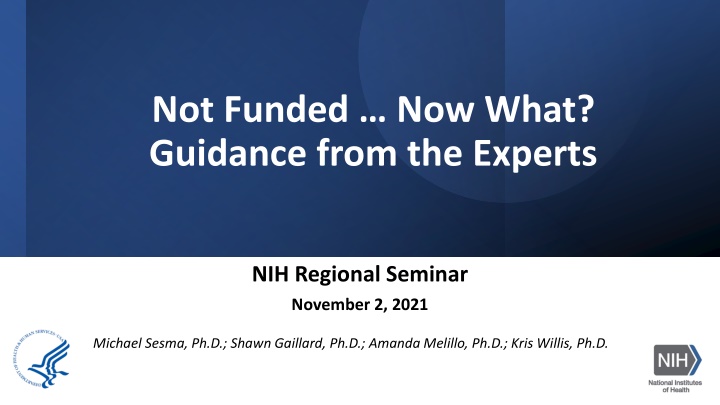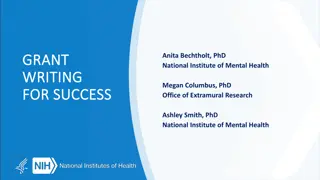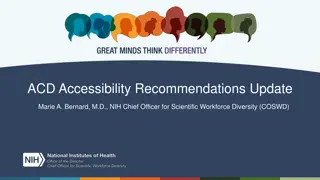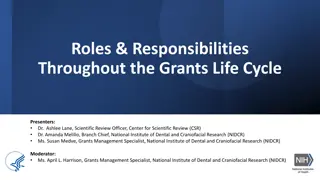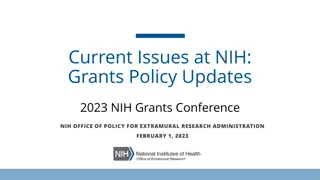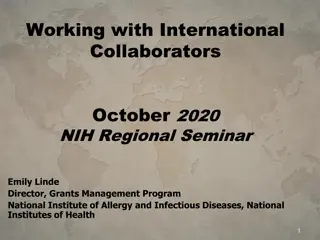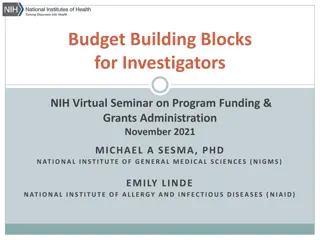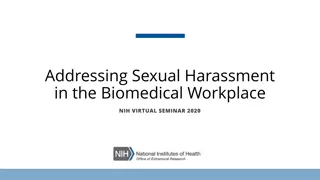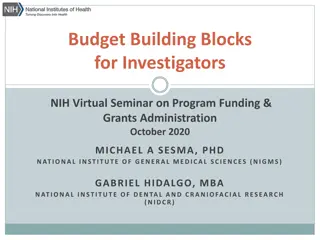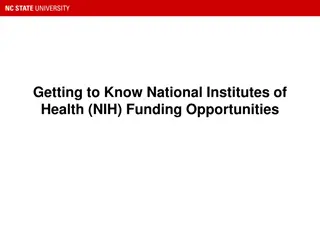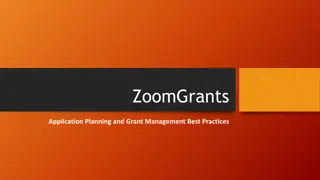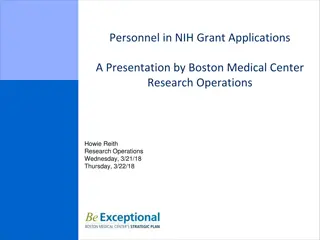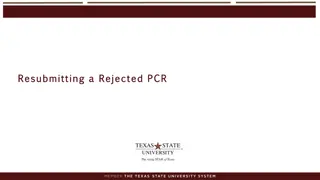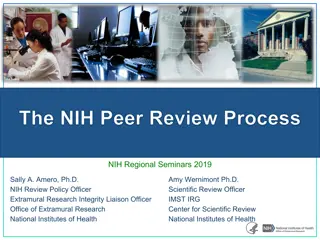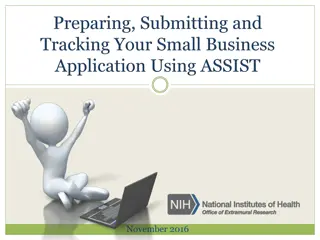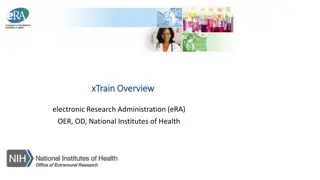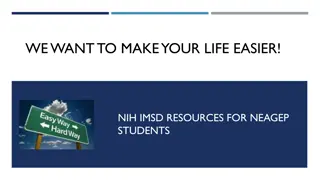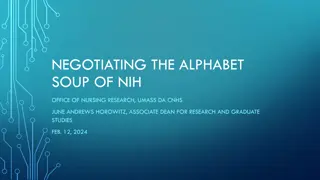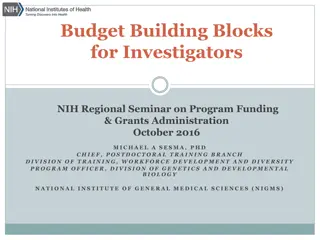Guidance on Resubmitting NIH Grant Applications
Receive expert advice on revising and resubmitting NIH grant applications for increased success rates. Learn when it's appropriate to resubmit or start a new project/application. Understand the key components needed in a resubmission and common submission errors to avoid. Utilize guidance from Program Officers for a strategic approach. Ensure you review critiques effectively and make impactful revisions for a stronger application.
Download Presentation

Please find below an Image/Link to download the presentation.
The content on the website is provided AS IS for your information and personal use only. It may not be sold, licensed, or shared on other websites without obtaining consent from the author.If you encounter any issues during the download, it is possible that the publisher has removed the file from their server.
You are allowed to download the files provided on this website for personal or commercial use, subject to the condition that they are used lawfully. All files are the property of their respective owners.
The content on the website is provided AS IS for your information and personal use only. It may not be sold, licensed, or shared on other websites without obtaining consent from the author.
E N D
Presentation Transcript
Not Funded Now What? Guidance from the Experts NIH Regional Seminar November 2, 2021 Michael Sesma, Ph.D.; Shawn Gaillard, Ph.D.; Amanda Melillo, Ph.D.; Kris Willis, Ph.D.
Should I revise and Resubmit? Critical Points Should I revise and Resubmit? Critical Points: Revised applications have a higher success rate than first time apps Contact your Program Officer to discuss the review and your plans for a revision Revised applications can include an Introduction page to summarize what has been changed in the revision Revised applications are assigned to the same review panel as before but may have different reviewers Reviewers have access to the prior review (Summary Statement) but not the original application
I. Determine when it makes sense to submit an amended application, and when it does not II. Describe important components needed in a resubmission III. Describe some common submission errors
When to resubmit, and when not! Shawn Gaillard, Ph.D. Developmental and Cellular Processes Branch GMCDB, NIGMS
1. Contact your Program Officer (PO)! PO Name/Contact info is listed on top left of your Summary Statement Email (don t cold call!) PO to set up a time to talk Have discussion of IRG critiques: strengths (same) & weaknesses (address) When to resubmit, and when not!
2. Resubmit or Not? You must have the Summary Statement back before you can resubmit Usually, best to regroup and resubmit - aptly addressing the previous reviewers' critiques But if substantial weaknesses (significance, investigators, innovation, environment & approach) then perhaps restart new project/new application If a lot of time passes before you can resubmit, reassess the science and consider submitting a new application instead of a resubmission, particularly if the science has evolved Discussion with PO can help you determine to resubmit or not NOTE - You must submit a new application (not a resubmission) if switching between a program announcement (PA) and request for application (RFA) or if changing grant mechanisms (e.g., R01 to R15) When to resubmit, and when not!
3. Must be in it to win it! Only way to NOT get funded is to Not apply; must be in it to win it! Investigators who successfully obtained new grants showed remarkable within-person consistency across multiple grant submission behaviors, including submitting more applications per year, more renewal applications https://www.ncbi.nlm.nih.gov/pmc/articles/PMC6135352/ When to resubmit, and when not!
4. Seek Wise Counsel! 5. Read before Write! Suggestion: Prior to resubmission ask your colleagues/mentors to serve as your own internal review panel before resubmitting to NIH. Have you addressed well the review critiques from the first submission? Read the FOA (again) before resubmitting. Are you using most recent announcement? Has anything changed since first submission? Does the FOA even allow resubmissions? (NIGMS R35 MIRA program does not, would need a new application), etc. When to resubmit, and when not!
Important components in a resubmission! Amanda Melillo, Ph.D. Integrative Biology and Infectious Diseases Branch DER, NIDCR
Tips for a Strong Resubmission Application Tips for a Strong Resubmission Application Capitalize on your strengths Respond point by point Include an introduction (required; one-page limit) Summarize the issues and criticisms and your response Summarize substantial additions, deletions, and changes If possible, address comments point by point Update the research plan and elsewhere in the body of your application as needed
More Tips for a Strong Resubmission Application More Tips for a Strong Resubmission Application Don't drop important details in favor of making space to address reviewer comments Identify changes by outlining them in your introduction Add new findings and your own improvements See what worked for others Be respectful even if you disagree Contact your PO. We can help guide you!
Other components to consider Other components to consider For non-RPG application types Multi-project applications: Must submit an introduction with the Overall component, but introductions within the other components are optional. Career development and fellowship applicants: Must arrange for resubmission of the three reference letters required for those programs.
Additional Considerations Additional Considerations You must submit the resubmission application within 37 months of the new, renewal, or revision application it follows. Note that identifying individual changes by using brackets, indents, or change of typography in the text of Specific Aims, Research Strategy, and other application attachments is no longer required, though NIH will continue to accept applications that contain the specific mark- ups. Use the most recent version of the FOA and forms, even if it's not the one you used originally.
Avoid common resubmission errors! Kris Willis, Ph.D. Cancer Cell Biology Branch, Division of Cancer Biology, NCI
Common resubmission errors Common resubmission errors 1. Not contacting your program director even if you are ND, you should call/email! 2. Not responding thoroughly to reviewer comments. Don t rush. It s better to wait for the next receipt date than to send an application back prematurely. 3. Missing the forest for the trees. Don t focus only on technical critiques and fail to make needed revisions to the big picture. 4. Panel hopping. Don t focus more on getting a different audience than on improving your application
Some resubmission errors are also Some resubmission errors are also common in first submissions common in first submissions 1. Undervaluing visual communication Leave good white space Make figure legends large enough to read Make sure figures labels are accurate and clear Use of bold text strategically Make good use of paragraph breaks 2. Not speaking to your audience The key to good grant writing is communicating your idea in a way that excites reviewers
